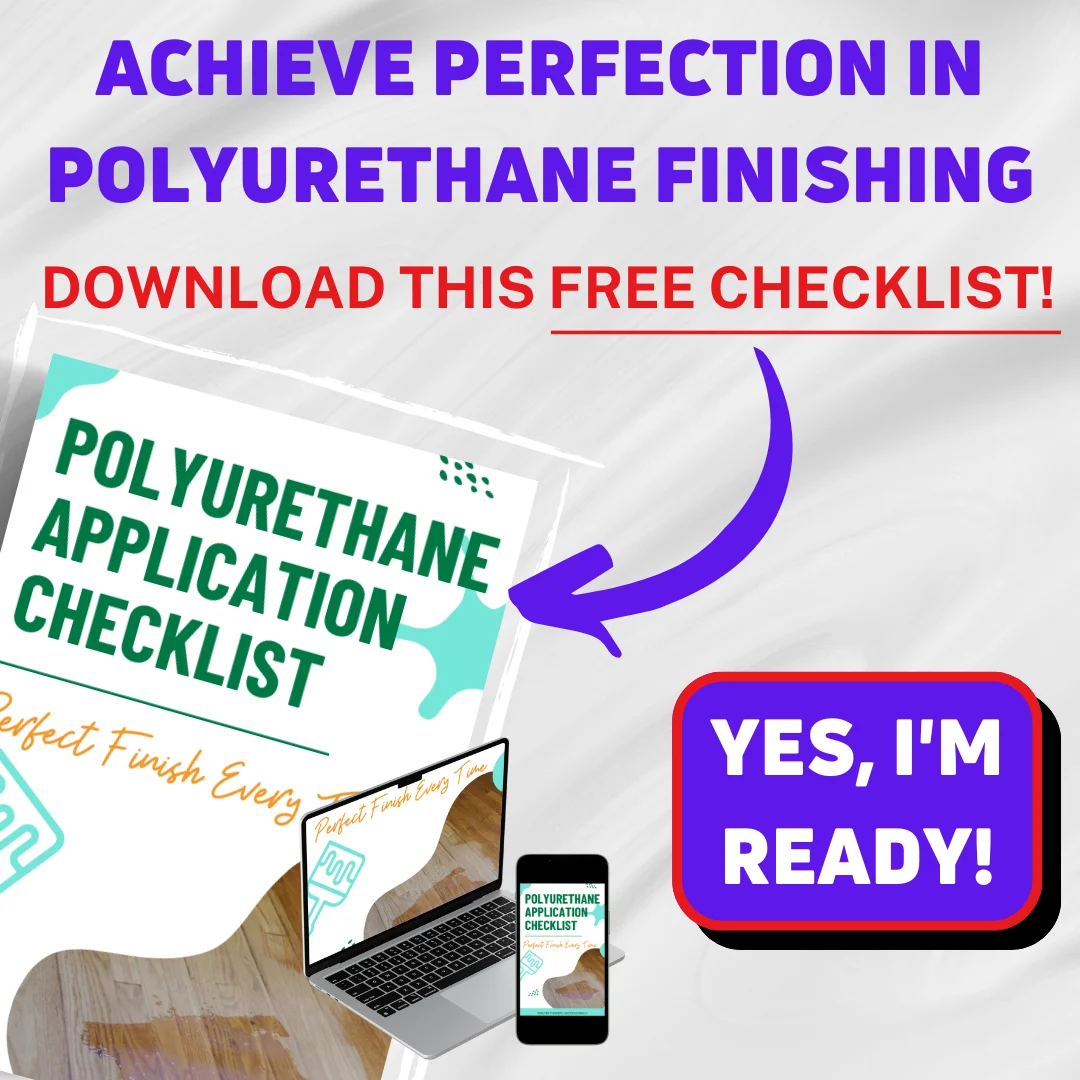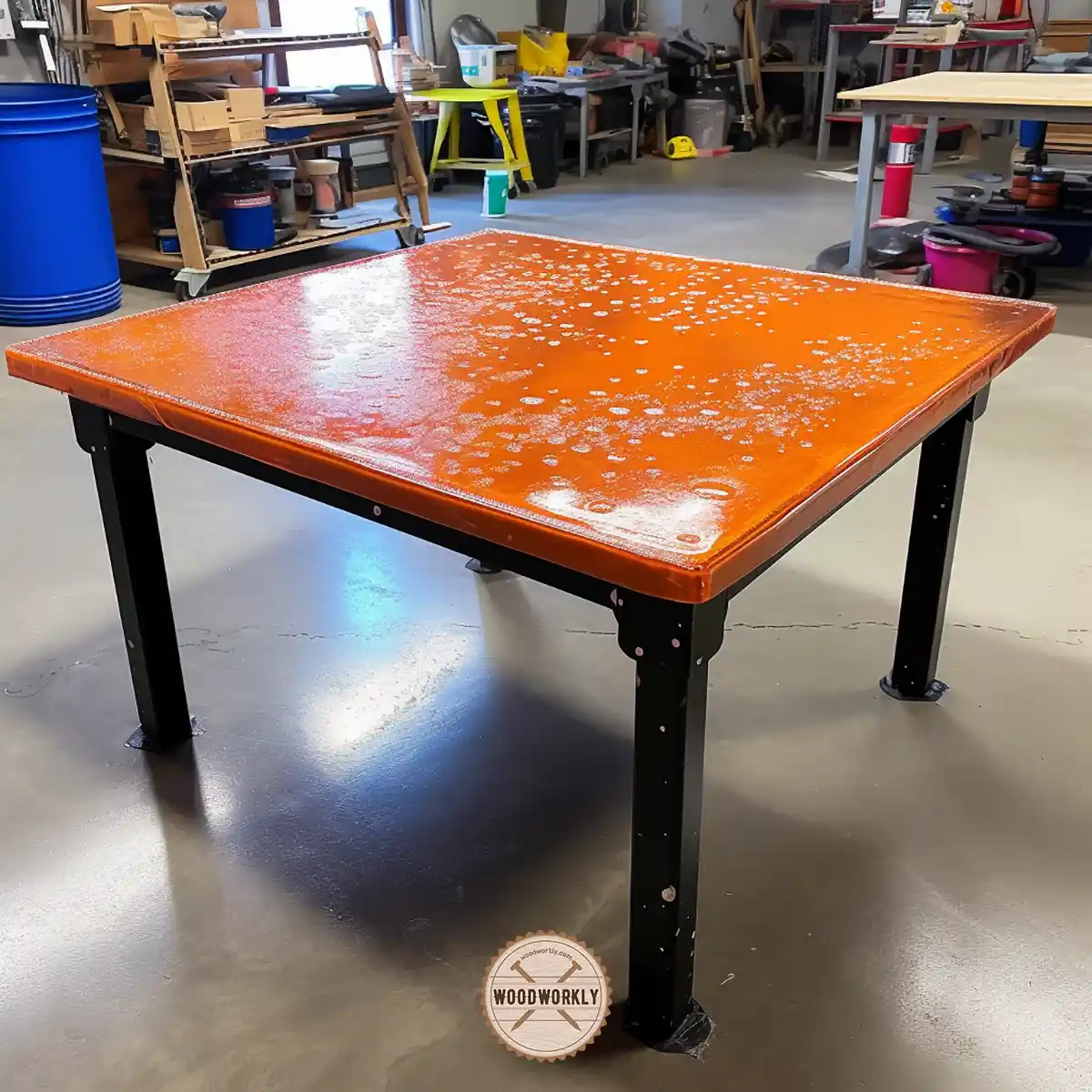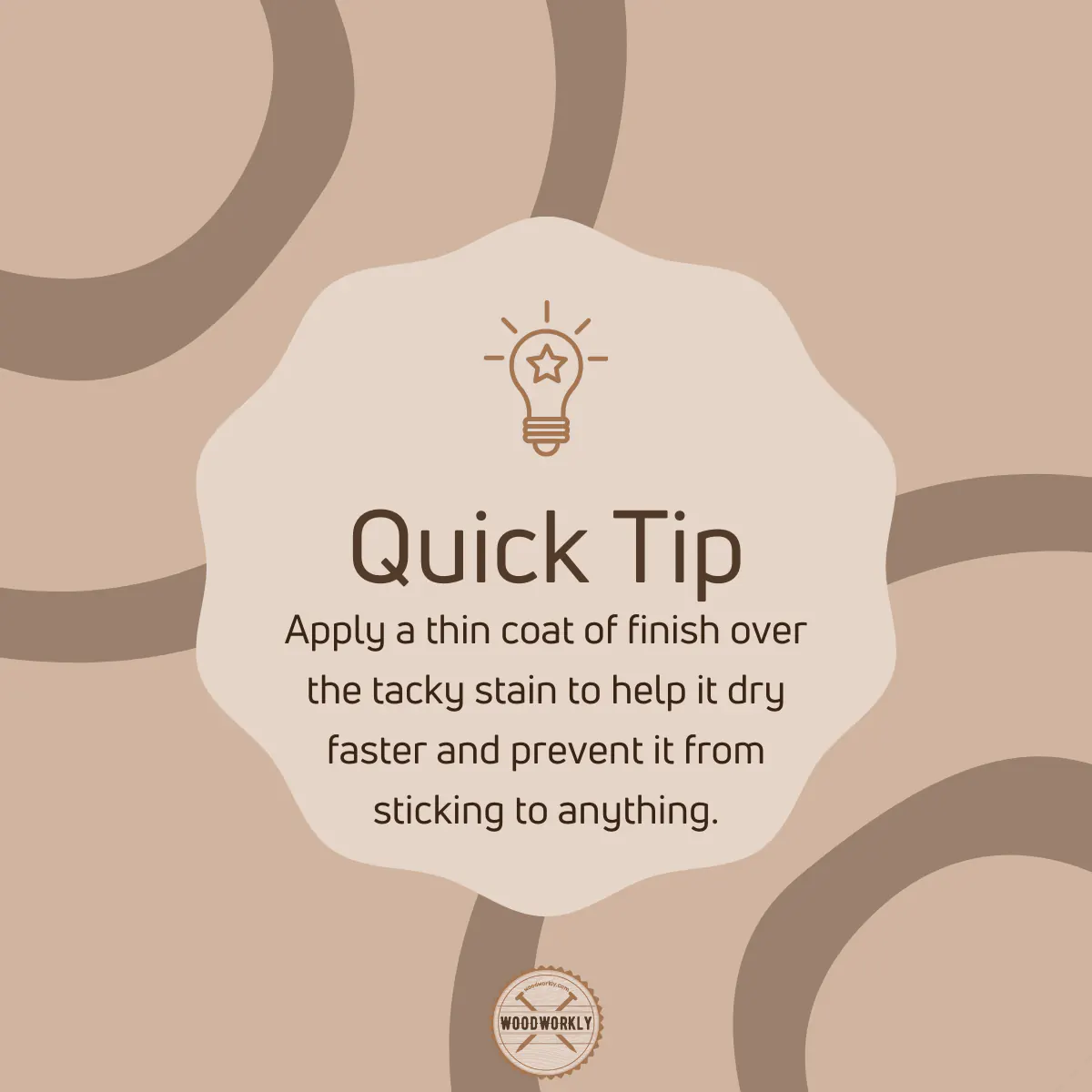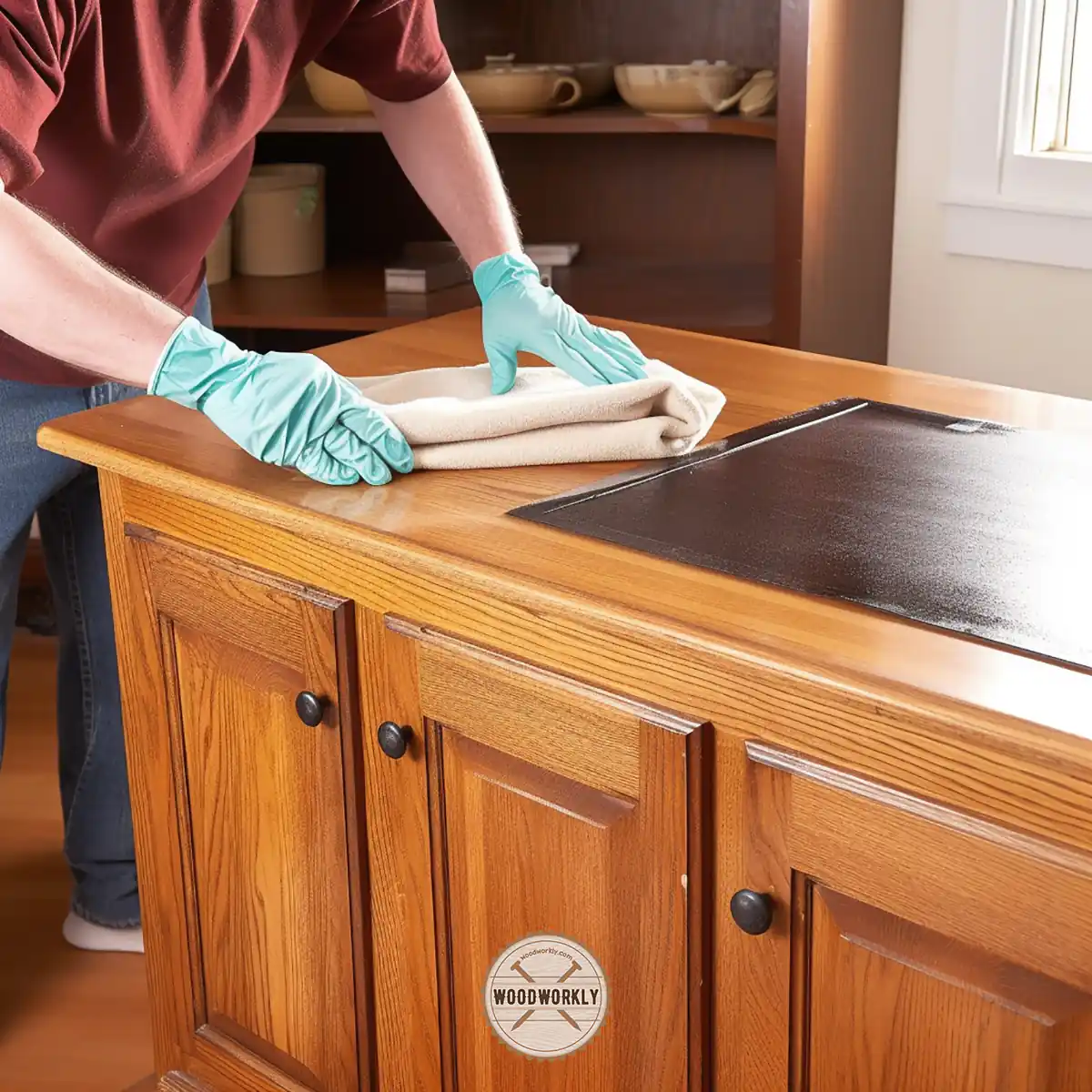Ever wondered if polyurethane can go over that tacky stain on your wood? Well, the answer is quite complex! Let’s delve into this woodworking mystery together, shall we?

Polyurethane gives an excellent finish to any kind of woodwork. It will protect the wood from scratches and give resistance to water damage.
Plus, it’ll give a nice-looking glossy appearance with a smooth finish to the wood. Before the application of polyurethane, the stain is applied to color the wood.
Sometimes wood stain doesn’t dry well and remains tacky for so long. Can you apply poly over it?
I have researched this and found useful information to share with you.
So, Let’s talk, Can you polyurethane over tacky stain?
No, you can’t. Never apply polyurethane over tacky stain since polyurethane is unable to bond effectively with the stain when it’s still sticky. This can result in an uneven, blotchy appearance and a weak, brittle finish that’s more prone to damage. Let the stain dry completely before applying polyurethane over it.
But that’s a quick snapshot and there’s a lot more to know about.

So, we’ll explore can you polyurethane over tacky stain and how to do that properly.
I’ll share my experiences as a woodworker to gain the best results when finishing the wood.
From this article, I’ll explore can you polyurethane over tacky stain without sanding the entire stain, will polyurethane dry over tacky stain, will tacky stain eventually dry, and how to remove tacky stain from wood before polyurethane.
Furthermore, I’ll answer some frequently asked questions as well.
So, just keep reading!

Will Polyurethane Dry Over Tacky Stain?
No, polyurethane never dries over tacky stain. If you apply polyurethane over tacky stain both finishes will be ruined.
Applying polyurethane over a tacky stain can lead to various issues and an unsatisfactory finish.
Once you apply the stain throughout the wood, it will penetrate through the pores of the wood structure.
The excess stain will remain on the surface and change the color of the wood. This is how wood stain works.
A well-dried stain ensures a smooth and even finish, allowing the polyurethane to bond correctly with the wood surface.
Inadequate drying time can lead to a sticky surface, which prevents proper adhesion of the polyurethane.
Read to know, How Long to Let the Stain Dry Before Polyurethane?
After the stain is applied you should let it dry completely.
It may take a few days. Once the stain is completely dried the surface is smooth, fresh, and gets a dark color tone as new.
Once you feel the stain is completely dry after a few days, you’re good to go for the polyurethane process.
But if you applied an unnecessarily excess amount of stain, the amount of stain that remains on the wood surface is high.
This excess amount of stain does not dry completely within a few days because of the high moisture level in the stain. The excess stain makes the surface tacky and sticky.
Once you apply polyurethane over tacky stain, the physical and chemical properties of the polyurethane layer will change due to the moisture content in the tacky stain below.
Therefore, polyurethane won’t dry, and it won’t attach well to the tacky stain layer.
This will waste the time, effort, and money you invested in this complete project.
For instance, imagine trying to glue two pieces of paper together when one is still wet with ink. The glue won’t adhere well, and the bond between the papers will be weak.
Read to know, Is Polyurethane Waterproof? Here’s the Truth!

What Happens If You Poly Over Tacky Stain?
If you apply polyurethane over tacky stain, solvents that are included in the wood stain will gas out and cause problems to cure the polyurethane with adhesion.
Solvents, moisture, and water particles that are included in wood stain evaporate when you keep the wood dry after proper staining.
But if the stain hasn’t dried properly, those solvents and water particles will remain inside the wood stain and make the stain tacky and sticky.
The polyurethane struggles to adhere properly to the sticky surface, which can result in an uneven, blotchy appearance.
This not only looks unsightly but can also affect the durability and longevity of your project.
Once you apply polyurethane over tacky stain those non-evaporated solvents cause problems.
After applying polyurethane you’ll notice spots that polyurethane adhered to the tacky stain layer and areas that it didn’t.
Polyurethane is considered a finisher that is hard to remove once it is applied.
But when it applies over tacky stain, polyurethane will start to separate itself from the tacky stain areas and bond well with the dried stain areas.
This is so difficult to remove.
I once worked on a dining table restoration project, and, in my haste, I applied polyurethane over a tacky stain.
As the days passed, the finish started to look uneven and blotchy, making the table appear unkempt and unappealing.
I had to strip the entire finish and start over, which cost me more time and money than if I had waited for the stain to dry completely.

Does Polyurethane Dry Even Though The Stain Is Tacky?
No, polyurethane does not dry even though the stain is tacky.
The capacity of polyurethane to adhere and dry correctly can be dramatically impacted by applying it over a sticky stain.
The tacky surface acts as a barrier, preventing the polyurethane from effectively bonding with the stain, which eventually results in an uneven and blotchy appearance.
The durability of the polyurethane layer is further weakened when polyurethane is placed over sticky stain.
Because of the weak link between the polyurethane and the stain, the finish is not only uneven but also more prone to wear and tear from regular use, which makes it less dependable and long-lasting.

Will Tacky Stain Eventually Dry?
Yes, tacky stain will eventually dry. But it takes a lot of time to dry naturally, and we cannot sure it’ll completely dry or not.
Tacky stain probably dries after 24 hours.
But sometimes surprisingly drying time can change up to 30 days or sometimes surface will be tacky forever.
The drying of the tacky stain can prevent due to the following factors,
- Amount of excess stain
- The moisture content of the tacky stain
- Humidity
- Cold temperature levels
- Dirty surface
- Compatibility issues
When the outside humidity level is high, moisture content inside the tacky stain doesn’t evaporate easily can delay the drying time.
Sometimes even though the stain is appearing dry, the underneath layer is not cured properly, and it can take up to 30 days to complete the curing process.
Let’s discuss each of those factors in detail to know how they affect the drying time of tacky stain and how to fix that.
1. Amount Of Excess Stains
I remember an instance where I applied too much stain on a dining table. The stain remained tacky even after several days.
The excess stain had created a thick layer on the surface, preventing it from drying and curing properly.
This taught me that moderation is key when it comes to staining.
2. The Moisture Content of the Tacky Stain
The moisture content of the stain itself plays a significant role.
If you’re using a water-based stain that still feels tacky, it might be because there’s still moisture present.
You’ll need to give it more time to fully evaporate.
On the other hand, an oil-based stain needs more time to react with air to dry.

3. Humidity
I once stained a wooden bench on an exceptionally humid day.
The high level of moisture in the air prevented the stain from drying as it normally would, leaving a sticky residue.
Thus, humidity levels play a crucial role in drying time, with high humidity leading to a more extended drying period.
4. Cold Temperatures
Cold temperatures can slow down the drying process of your stain.
Stains typically dry quickly between 60-80°F (15.5-27°C). Below these temperatures, the drying process may be slow or even halt, leaving the stain sticky.
I learned this the hard way when I attempted to stain a bookshelf in my chilly garage during winter.
5. Dirty Surface
One might underestimate the impact of a dirty surface on drying time.
If dirt, dust, or other materials are on the wood’s surface, the stain may not adhere correctly, leading to a sticky surface.
I recall having to re-sand and re-stain a project after I neglected to clean the surface adequately before staining.
6. Compatibility Issues
The type of wood you’re staining can also affect drying time.
Some woods are too dense or oily to absorb the stain properly, causing the stain to remain on the surface and appear tacky even after drying.
A mistake of staining a dense wood, like Ipe, with a standard wood stain, gave me a valuable lesson in the importance of compatibility between wood and stain.
As you can see, the drying time of tacky stain depends on various factors, from the amount of stain applied to the temperature and humidity levels to the compatibility between the stain and the wood.

How Long to Let Stain Dry Before Polyurethane?
After applying wood stain, let the stain dry for at least 48 hours before applying polyurethane.
This gives enough time for the stain to spread evenly throughout the wood and make an even color shade.
But this drying time can differ due to extreme weather conditions, poor ventilation, and many more.
Once you feel the stain is dried properly, check the resulting color, and then apply a polyurethane finish on top of the stain all over the wood.
Polyurethane will tightly bond with stain and help the wood to protect from outside elements.
How To Remove Sticky Stain from Wood Before Polyurethane?
Once you receive a tacky stain because of mistakes did when staining, the best thing to do is wait until it’s completely dried.
But when you realize the tacky stain doesn’t dry quickly, the best option is to sand down the entire stain layer and re-apply the wood stain.
But this time you need to make sure that no mistakes should happen when wood staining.
Tacky stain can be removed by following the below steps,
- Sand the tacky stain with 150 grit sandpaper.
- Remove all the remaining stains.
- Clean the wood and remove sawdust using a rag or old cloth.
- Re-apply the wood stain correctly.
- Let the stain dry properly.
- Apply polyurethane over stain.
- Let the polyurethane layer dry properly.
Before applying polyurethane over the dried stain surface, read my latest article about fixing polyurethane mistakes to achieve an even surface without forming blotches due to poly.
Make sure to clean your polyurethane brush properly once the project is done!

Apply Stain Thinner to Eliminate Tacky Stain
Apart from re-sanding the whole tacky stain layer and starting the project from the beginning, you can apply to stain thinner to the tacky stain.
Stain thinner will remove the excess stain which causes the tackiness.
Here’re the steps you need to follow when removing the tackiness of the stain with thinner.
Step 1: Gather Your Materials
Before diving into the process, make sure you have all the necessary materials. You’ll need:
- Stain thinner (choose a thinner compatible with your stain type, either water-based or oil-based)
- Clean, lint-free rags or paper towels
- Gloves to protect your hands
- A well-ventilated workspace
Step 2: Test the Thinner
Before applying the stain thinner to your entire project, it’s wise to test it on a small, inconspicuous area.
This will help you gauge the effectiveness of the thinner and ensure it doesn’t damage the wood or alter the color of your stain.
Step 3: Apply the Stain Thinner
Wear your gloves and dampen a clean, lint-free rag or paper towel with stain thinner.
Gently rub the tacky stain area in a circular motion, taking care not to press too hard or remove too much stain.
The goal is to remove the excess stain and promote even drying.

Step 4: Assess the Results
After applying the stain thinner, take a step back and assess the results. If the tacky areas have improved but still feel sticky, you may need to repeat the process.
Remember, it’s better to apply the stain thinner in thin layers and repeat the process than to apply too much at once and risk damaging the wood or stain.
Step 5: Allow the Stain to Dry
Once you’re satisfied with the results, give the stain ample time to dry in a well-ventilated area.
Once you’re satisfied with the remaining stain layer, let it dry completely and apply the polyurethane over the stained surface.
Keep in mind that the drying time may vary depending on factors such as temperature, humidity, and the type of stain used.
Make sure to wipe the surface immediately when you apply stain thinner to the wood.
When you’re wiping the surface after applying stain thinner, the excess stain should leave the wood and come to the wiping cloth you use.
Applying stain thinner is better for small tacky stain surfaces and re-sanding and starting over from the beginning is good for large woodworking projects.

That’s it, folks! now you know everything you need to know about, can you polyurethane over tacky stain.
Let’s see some other occasions you might have to deal with when working with tacky stain surfaces.
Can You Polyurethane Over Gel Stain?
If the gel stain is oil-based, you can polyurethane over gel stain. But if the gel stain is a water-based product, you can never apply polyurethane over stain.
This is because of the incompatibility between water and oil-based products.
You can polyurethane over oil-based stain but not over water-based stain.
Other than that, you can polyurethane over gel stain without any issue.
But always make sure to let the gel stain surface dry completely before applying the polyurethane layer.
Can You Varnish Over Tacky Stain?
You can never apply varnish over tacky stain unless you remove the whole tacky stain.
Here’re the steps you need to follow to get an idea about how to varnish over tacky stain properly.
- Re-sand the whole surface and remove the tacky stain.
- Then clean the surface with a rag or cloth.
- Apply wood stain all over the wood without making it tacky or sticky.
- Apply varnish once the stain is completely dried after 2 days.
Also, you can stain over varnish with proper sanding and finishing once the stain is completely dried.
Read my latest article to know the procedure of applying varnish on any wood without forming brush marks!

So, let’s answer some frequently asked questions as well.
FAQs
Why is my stain still tacky after 24 hours?
This could be due to several factors, including a high humidity environment, cold temperatures, or simply applying too much stain. It’s crucial to apply stain in thin, even layers and allow ample time for each layer to dry.
How can I speed up the drying process of a tacky stain?
One effective method is to apply a stain thinner, which can help remove excess stain and accelerate drying. Just remember to use a thinner compatible with your stain type (water or oil-based).
Can I apply polyurethane over gel stain that is still tacky?
Gel stains are a bit different from traditional stains, but the principle remains the same. It’s best to allow the gel stain to dry fully before applying polyurethane to ensure a smooth and even finish.
How long should I let a stain dry before applying polyurethane?
This can vary depending on the type of stain, the environmental conditions, and the thickness of the stain layer, but typically, you should let it dry for 24 to 48 hours.
Can I sand a tacky stain to help it dry?
Sanding a tacky stain is not recommended as it can lead to an uneven finish. Instead, try using a stain thinner or simply allow more time for the stain to dry naturally.
Did I cover all you wanted to know about: Can You Polyurethane Over Tacky Stain?
In this article, we have deeply gone through Can you polyurethane over tacky stain and how it is done properly without making any mistakes.
You should not apply polyurethane over a tacky stain. A tacky or sticky stain indicates that it hasn’t fully dried, and applying a polyurethane topcoat at this stage can lead to an uneven finish and poor adhesion. Always ensure the stain is completely dry before applying polyurethane.
Furthermore, we have discussed how to remove tacky stain from wood before polyurethane and answered some frequently asked questions as well.
As a woodworker, my advice is, never to try to apply polyurethane over tack stain.
Once you get a tacky stain, apply stain thinner and remove excess stain or re-sand the project and start the task from the beginning.
Hope you’ve gained good knowledge about the hot topic, Can you polyurethane over tacky stain.
So let’s begin to finish the next woodwork project using stain and polyurethane. Have fun!
Moral of the story let the stain dry! Great article ty!!